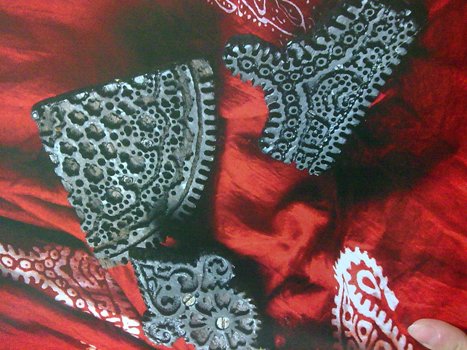Kelagayi: a unique silk headscarf of beautiful Azerbaijani women

By Aynur Jafarova
Azerbaijani women are beautiful and tender as God made them that way. Their exceptional beauty, tenderness and attractiveness would be complete with the silk touch of kelagayi.
Kelagayi is Azerbaijani women's national headscarf made from fine and soft silk in a four-cornered shape. Kelagayi is an integral part of women's national costume in Azerbaijan. Silk kelagayi protects them from both the hot sun and cold wind as silk is cool in summer and warm in winter.
Kelagayi, known as "chargat" in the western regions of Azerbaijan, has been produced in Azerbaijan since the ancient times. Azerbaijani cities such as Ganja, Shamakhi, Sheki, and Nakhchivan, and Basqal settlement of the Ismayilli region were famous for high quality kelagayi production.
Kelagayis differ from each other for their color tints and sizes. Unmarried girls would cover their heads with kelagayis of bright colors, such as yellow, pink, gold or purple, while dark colored kelagayis were reserved for older women.
Traditionally, particular colors of kelagayi were associated with a particular event. For example, if there was a funeral, the women usually wore a dark kelagayi. For her wedding, the bride would wear a bright red scarf and her face was covered. Another interesting fact is that the bride's family gave the groom a present of a kelagayi.
Kelagayis were traditionally square-shaped and regular in size
-- 150x150 or 160x160 cm.
The important part of any kelagayi is a pattern inscribed on it
with the "basmanakhish" method. Every pattern on the "yelan"
(frame) and "khoncha" (center) of the kelagayi has a different
meaning and is associated with botanic, isomorphic and geometric
shapes. The main figure used in kelagayi is buta.
Kelagayi makers use special color essences in the design process. Those of blue, red, mandarin, yellow, violet and purple colors are made from various plants, in particular, barberry, wild orange, wild apple, saffron, currant, hornbeam tree, and broom roots.
The most famous kelagayis are "Shah buta", "Saya buta", "Khirda buta", "Heyrati", "Soghani", "Istiotu", "Albukhari", "Abi", "Gonshuchatladan", "Baghdadi", "Shamakhi", "Bestenigar", "Gelinlik", "Gizili", "Mikheyi", "Yemishani", "Zeytuni" and "Yelani".
Currently, there are special dynasties that continue the tradition of kelagayi making. The successors of the Shamilovs dynasty, in particular, grandchildren of Shovkatziya Shamilov, are specialists of this profession.
An Azerbaijani woman wearing a kelagayi looks so beautiful and attractive because she bears our traditions and customs. Kelagayi as a symbol of beauty, grace and honor was a special and valuable present for a girl who was getting married.
According to historical sources, kelagayi made in Basqal, a picturesque place in the northern-central part of Azerbaijan, was exported to India, Central Asia, Russia, Italy, France and other countries and highly appreciated there. Basqal masters bought silk from Sheki, Gabala, Ordubad, Kutaisi and Samarkand. It shows that Basqal had broad economic and trade relations with Azerbaijani and foreign cities.
Since the 19th century, Azerbaijan has attended international exhibitions in Russia and western Europe by presenting its craftsmanship samples. In 1862, Azerbaijan was first introduced at an international exhibition held in London where an artisan from Basqal, Nasir Abdulaziz, was awarded with a silver medal and a diploma for weaving an excellent kelagayi and ganovuz (colorful silk material).
Basqal is also known for its Silk Center and Kelagayi Museum, which provides visitors and tourists with a comprehensive picture of this ancient Azerbaijani art. In the museum visitors are told about the history of kelagayi making as well as the patterns and their meanings.
Weaving kelagayi consists of several stages. The first stage is the production of silk threads. The thinnest thread is requested for kelagayi weaving.
The material woven in the loom is cut and boiled in water. Then it is hanged for drying. After drying, the kelagayi is decorated with patterns.
Patterns are put on a kelagayi with a stamp which is called galib and made from pear, nut and wild apple trees. The most famous stamps are "gunesh", "pullu qelib", "simayi-shems", "hashiye", "boyuk buta", "kichik buta", "medahil", "khary bulbul", "khetayi", "kepenek", "chobanyastigi", "chiyelek" and "aypara".
After design, the kelagayi is colored in a dyeing facility called "kup dami" in Azerbaijani. Coloring is the most difficult part of the process and is a very responsible job. A good specialist knows how long a piece of silk should stay in the dye.
Kelagayi weavers say that the dyeing and design of kelagayi is compared with Azerbaijani mughams (folk music): they believe that the use of seven colors is linked to the number of mughams.
The work done for the inclusion of "the art and symbolism of Azerbaijani kelagayi" in the intangible cultural heritage list by UNESCO is a graphic example of the care of the Azerbaijani state for the ancient folk art and national heritage.
Here we are to serve you with news right now. It does not cost much, but worth your attention.
Choose to support open, independent, quality journalism and subscribe on a monthly basis.
By subscribing to our online newspaper, you can have full digital access to all news, analysis, and much more.
You can also follow AzerNEWS on Twitter @AzerNewsAz or Facebook @AzerNewsNewspaper
Thank you!
